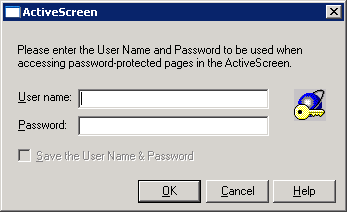Friday, December 2, 2022
How to find the number of times that a string occurs in the server response in NeoLoad?
Thursday, November 17, 2022
Script version is newer than TruClient version | Script version (12.62.703.0) is newer than TruClient version (12.55.1333.0)
Friday, September 16, 2022
Active screen Error in Load runner | "Please enter the User Name and Password to be used when accessing password protected pages in the Active Screen."
Sometimes when you replay your vugen script or stop the replay, you may see the active screen error pop up or the error "Please enter the User Name and Password to be used when accessing password protected pages in the Active Screen." or you may keeps getting ActiveScreen dialog box.
To resolve this we have below solutions:
Method 1: Set the Internet Explorer to not prompt for a Certificate.
- Go to Internet Explorer --Tools-- Internet Options -- Security tab
- For the Local Intranet and Internet, Hit Custom Level--Enable "don't prompt for client certificate selection when no certificates or only one certificate exists..."--Close the browser and run the script.
Method 2:
- Go to run-time-setting--preferences--Check-in WIninet replay instead of Socket(Window only)
- Go to run-time-settings--preferences--options-- take value yes for Authentication: use window native NTML implementation and override credentials in window native implementation
- In VuGen Disable the Runtime Viewer
- Go to Tools--General options --Display --and uncheck "Show browser during replay"
- When the script is load tested in LRE or Controller, by default Runtime Viewer is disabled. so you may not see this error there.
- Open the registry (Start Menu -- run -- regedit)
- Browse to HKEY_LOCAL_MACHINE\SOFTWARE\Microfocus\Interactive\LoadRunner\Vugen\Thumbnails
- Set the GenerateThumbs key to 0 (the default value is 1)
Thursday, September 15, 2022
Get the current iteration number in neoload | iteration number in neoload using javascript
context.currentVU.getCurrentIteration();
Unless your test is run iteratively, in which case you may predict the final iteration number, you cannot know the last iteration.
Friday, September 2, 2022
How to Clear the Cache and Cookies in Neoload | web_cache_cleanup(); & web_cleanup_cookies() in Neoload
context.currentVU.clearCache();
context.currentVU.clearCookies();
Monday, August 29, 2022
Free LoadRunner download | Micro focus Load Runner free trail version download
Previous links were not working for free download of Vugen and Analysis tools. We can download the latest software trails from the below link. We now have a gated access to LRP community edition. You can sign up to get access using this link.
https://www.microfocus.com/en-us/products/loadrunner-professional/free-trial
When you finish, Micro Focus team will send you the download links. You will discover that the software has a community license built in when you download and install it. To verify this, launch the LR license utility. Please be aware that the community bundle license is only intended for use in the development of tests and the execution of proof-of-concept projects. All protocols—aside from COM/DCOM, templates, and GUI Virtual Users—are included in this community bundle. Commercial usage of the community package is expressly forbidden and it is given without any type of support or warranty.
Sunday, August 28, 2022
What is Wasted Time ? | LoadRunner Vugen Wasted Time
For Web http html script, the time taken for web_reg_find or web_reg_save_param functions to look for a particular string in the response buffers, is counted as wasted time. The transaction time includes the ''wasted time'' but it is subtracted from transaction time when displayed in Controller and Analysis.
The wasted time does not include the time spent writing the Vugen log file and the Vuser log files. The actual elapsed transaction time is increased by the logging time. The function lr get transaction duration() returns the real amount of transaction time that has passed. The analysis and creation of test scripts may benefit from this knowledge.
You can retrieve the total wasted time (both that generated automatically and that added with lr_wasted_time) with the function lr_get_transaction_wasted_time(), or with lr_get_trans_instance_wasted_time(), as appropriate.
Saturday, August 27, 2022
Write transaction responses to a text file in Vugen Load runner | Capture transaction response times load runner | Capture and display the response times from replay log vugen LoadRunner
{
double trans_time;
int status;
web_cleanup_cookies();
web_set_sockets_option("SSL_VERSION", "TLS1.2");
web_set_max_html_param_len("999999");
lr_start_transaction("Digital_HondaCity_01_HomePage");
web_url("AirVistas",
"URL=https://Airvistas/service/access/findseat/",
"TargetFrame=",
"Resource=0",
"RecContentType=text/html",
"Referer=",
"Snapshot=t10096.inf",
"Mode=HTML",
LAST);
trans_time = lr_get_transaction_duration("Digital_HondaCity_01_HomePage");
lr_end_transaction("Digital_HondaCity_01_HomePage",LR_AUTO);
if (trans_time)
lr_output_message("The duration of DHC Home Page : %f seconds", trans_time);
else
lr_output_message("The duration cannot be determined.");
return 0;
}
Here is the output:
Friday, August 26, 2022
NL-NETWORK-01 error in NeoLoad
Error Code: NL-NETWORK-01
Message:
Network error: An IO error occurred sending the request.
Details:
java.net.SocketException: Network is unreachable: no further information
Thursday, August 25, 2022
NL-NETWORK-02 BindException errors in Neolaod | Neoload NL-NETWORK-02 error
Reboot the computer hosting the Load Generator after adding the following values to the \HKEY_LOCAL_MACHINE\SYSTEM\CurrentControlSet\Services\Tcpip\Parameters key using regedit.
MaxUserPort - 65534 -(REG_DWORD, decimal)
TcpTimedWaitDelay - 30 - (REG_DWORD, decimal)
How to add a cookie in Neoload | Web_add_Cookie in Neoload | How NeoLoad manage cookies?
context.currentVU.setCookieForServer("Domain=www.easyloadrunner.blogspot.com","Environment=CityLS");
Wednesday, August 24, 2022
Generate current date or Timestamp in NeoLoad using JavaScript | NeoLoad date variable | Get Date/Time in UTC in JavaScript

Tuesday, August 23, 2022
Get epoch timestamp in Neoload | epcoh time stamp java script with neoload
How to delete unwanted files and results folders from LoadRunner scripts folders
This batch file can be run either from within a script folder, or from a top-level folder containing multiple LoadRunner scripts. If run in a top level folder it loops through all sub-folders deleting files and results folders as it goes. It deletes unwanted log files and output files
Monday, August 15, 2022
How to Record Desktop Applications Using Jmeter | Desktop application load test with Jmeter
- Open "Internet Options" from Control Panel.
- Click on "Connections" Tab and Click on "LAN settings"
- Go to Proxy Server tick the "Use proxy for your LAN"
- Edit the localhost as address and 9091/9092 as port (Do not use 8080/8888 ports) then click OK
- Disable or uncheck the Automatically detect settings
- Use this same Proxy setting in JMeter proxy Server and please keep in mind that do not open any other application that use the same network .
- Start Proxy in JMeter and Open the desktop Application, and now record it. That's it
Capture the count of parameters in a file Neoload | Loop the parameter count times in Neoload | Neoload java script container
var fileName = "C:\\Users\\NeoloadScripts\\Desktop\\Userid.txt";
Note: you can use any file here either txt or csv or any other text formats
//Read the File and get line count
var reader = new Packages.java.io.LineNumberReader(new Packages.java.io.FileReader(fileName));
while ((reader.readLine()) != null) {}
var lineCount = reader.getLineNumber();
reader.close();
If a file variable has a column header line, alter the value by deducting 1 from the value; otherwise, don't use.
var lineCount = lineCount-1
//Log value of line count from file
logger.debug("Line number is = "+lineCount);
//Return to the Neoload script a variable with the value of the line count.
context.variableManager.setValue("LoopCount",lineCount);
After this java script go to the go to the loop and in the settings-execute loop enter ${LoopCount} as shown in below.
Tuesday, August 9, 2022
Load runner to Neoload script converter with a command line tool | LR to Neoload Script Converter
A command-line utility called The Script Converter transforms LoadRunner scripts into NeoLoad projects.
Download the tool from here {Neotys Lab}:
Open Command Prompt and enter the following Command:
-source <LR Scripts folder> -target <NeoLoad output directory> -project <NeoLoad Project name
Example:
Windows: .\script-converter.bat -source "C:\LoadRunnerScripts\TestHome" -target "C:\Users\Documents\NeoLoadProjects\TestHome" -project "TestHome"
Linux/OSX: ./script-converter.sh -source "/home/user/LoadRunnerScripts/TestHome" -target "/home/user/NeoLoadProjects/TestHome" -project "TestHome"
NeoLoad output directory - The folder of the created NeoLoad Project
NeoLoad Project name - The name to assign to the NeoLoad project
Saturday, August 6, 2022
How to convert LoadRunner script to NeoLoad project? | NeoLoad Script Converter
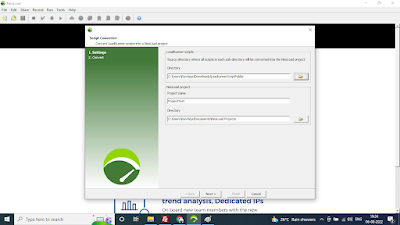
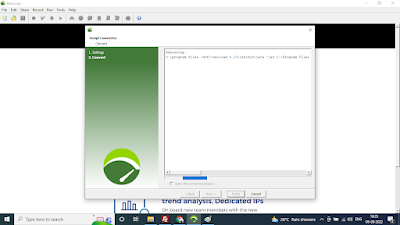
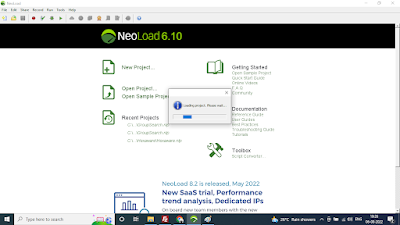
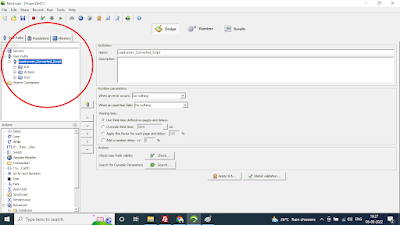
Friday, July 29, 2022
One or more files in the script's folder is in use,preventing script replay,Close the files and try to replay the script again.Vugen Error

1) Please check that Explorer not open on replay script folder ( probably result1 )
2) please check that any files from result1 folder is not opened on external editor / browser
3) please check on Task Manager that there isn't any process of HP.Utt.StandaloneDebugger.exeY
4).You can run the command line utility 'handle.exe' to show all opened files per process. Save the output and check for your LR script directory.
5).Run procmon.exe and define the filters such that you monitor the load runner processes or the script folder. Start your test and check which open of existing file is failing.
Load runner Analysis Granularity issue - Reduce for all Graphs is not working
1. Open the "Tools > Options > Result Collection" tab before loading the result (before starting a new session).
2. Choose "Data Aggregation > Apply user-defined aggregation" from the drop-down menu.
3. Select "Aggregation Configuration" from the drop-down menu. There, in the field "Select the granularity you wish to utilise," type the number you require.After that, you can use the option to reduce the granularity of several graphs.
Error -35196: HTTP Status-Code=422 (Unprocessable Entity) for "https://easyloadrunner.blogspot.in", Snapshot Info [MSH 2 5] [MsgId: MERR-35196] VUGEN Load runner error
This 422 error can also happen because a script is trying to run, but the server does not have permission for that particular file. This could mean you need new permissions on your web hosting account, or it's caused by an improperly set up PHP configuration in your site's root folder.
The422 Unprocessable Entitystatus code is a client-side error. It belongs to the HTTP response status codes in the 4xx category, called client error responses.
If you're not getting any messages about the problem, your web host might not allow access to these logs. If this is indeed the case, we recommend switching providers as soon as possible because this 422 error could indicate a bigger issue with your site, such as malware or something else security-related.
If you can access your logs, then the next step is to look for exceptions. These errors can be caused by a script that's trying to run but cannot because of improper permissions on the webserver or improperly set up PHP configuration in your site's root folder. If this isn't working, it could also be an issue with the script itself, which can be solved by contacting a developer.
Another way of fixing the 422 Unprocessable Entityerror code is to upload a fresh version of the script to your server. Some people can do this through FTP, while others may need assistance from their hosting provider.
Saturday, March 5, 2022
Read or Write a Notepad with load runner or Read Write text file in load runner Vugen
Wednesday, February 9, 2022
ctrx_type and ctrx_key functions in Citrix Protocol in Load runner
Syntax:
ctrx_type (string)
ctrx_key (key, key modifier)
To send special keyboard commands like Alt-F, ctrx_key can be used.
Wednesday, January 26, 2022
java.util.prefs.WindowsPreferences WARNING: Could not open/create prefs root node Software\JavaSoft\Prefsat root 0x80000002. Windows RegCreateKeyEx(...) returned error code 5.
Wednesday, January 5, 2022
How to correlate Cookies in LoadRunner? or Vugen?
If the cookie to be correlated is a Client side cookie generated by Java code then you need to understand the logic behind the cookie generation.Then try to write a C program that generate a similar cookie.


